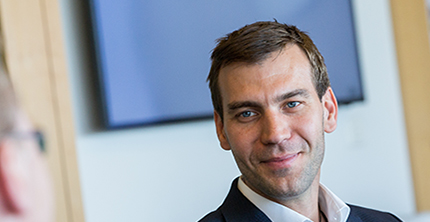
“We were so scared of our IPO”: Leaders Unplugged with former On-CEO Marc Maurer
Marc Maurer shares how ON grew from startup to IPO by defying hype, focusing on purpose, and leading with humility in this candid Leaders Unplugged episode....

by Nia Choi, Christoph Glaser Published June 19, 2024 in Leadership • 6 min read
Mindfulness is not a luxury, but a necessity for leaders today. Endless back-to-back meetings and the pressure to innovate, coupled with the need for swift decision-making, often leave little room for thoughtful reflection. That’s made more challenging by the epidemic of distraction and constant stimuli, driven by smartphones and digital technology.
Presence – a state of inner calm that allows you to stay aware and engaged in the present moment – is one antidote to this onslaught. Through breath-based mindfulness, leaders can train their “presence muscle” while letting go of stresses and tensions.
Why is mindfulness so critical to leaders right now? Because the speed of technological change is nothing short of staggering. In just the last few years, humanity has produced 90% of all the data ever generated. Predictions from the World Economic Forum (WEF) suggest that nearly a quarter of today’s jobs may cease to exist within the next five years, either because they have evolved or been rendered obsolete. And yet, the pace of change is only accelerating, indicating that the world will likely never change as slowly as it does today.
As a result, leaders are constantly running. Yet to be agile and capable of innovation, creativity, and transformation, they must combine speed with inner calm. This allows them to be able to foresee developments in their environment, understand and integrate multiple perspectives, and respond flexibly and swiftly to changing circumstances.
However, the urgency to innovate can lead managers to act impulsively and reactively, compromising performance. The key lies in cultivating mental presence, which allows leaders to access their emotional intelligence and use their creative potential and intuition to harness the collective intelligence of their teams. Breath-based mindfulness offers a pathway to achieve this equilibrium, enabling leaders to respond creatively and with agility to the challenges they encounter.
By cultivating mental presence through breath-based mindfulness, leaders can ensure that their decisions are rooted in thoughtful consideration rather than panic or habit. This deliberate approach to problem-solving becomes a cornerstone of agility, allowing leaders to navigate the ever-changing business landscape with clarity and purpose.

“Studies have shown that the attention span of employees has decreased from 150 seconds (about two and a half minutes) in 2004 to just 44 seconds in 2021, with the average person checking their phone up to 150 times a day.”
Research supports the idea that mindfulness enhances the frequency and experience of “flow” – a state characterized by deep immersion, intense focus, creativity, and inner calmness. The impact of flow is remarkable, as evidenced by a McKinsey & Company study of more than 5,000 managers, which found that they were five times more productive when in a state of flow.
However, achieving mental presence is particularly challenging in today’s digital work environment, exacerbated by the COVID-19 pandemic’s shift towards remote and flexible work models. The constant barrage of digital distractions has shortened attention spans, making it even more crucial for leaders to bolster their resilience and train their minds to stay present.
Studies have shown that the attention span of employees has decreased from 150 seconds (about two and a half minutes) in 2004 to just 44 seconds in 2021, with the average person checking their phone up to 150 times a day. Mindfulness provides us with the tools to cultivate focus in the face of constant stimuli.
Fortunately, mindfulness is a skill that can be developed and strengthened through regular practice. Companies like Google, SAP, Accenture, and Deutsche Telekom are already investing in mindfulness training for their managers and employees, recognizing its potential to enhance performance and well-being.
Its effectiveness was proven in a recent study, which found that senior leaders who participated in breath-based mindfulness training showed significant improvements in well-being, health literacy, and performance, even three months after the training.
“One such intervention is the “breathing anchor,” where leaders are encouraged to maintain awareness of their breath, which can be done at any time.”
However, when we’re under significant stress, we tend to resort to reactive behaviors. To avoid this, we must create a gap between a stimulus and our reaction, allowing us to respond intentionally rather than instinctively.
Consistent practice is key, and training should occur as a preliminary step. Just as athletes train off the field to excel during game time, leaders must commit to daily mindfulness exercises to build resilience and mental clarity. This could involve simple breathing techniques or brief moments of meditation for 10 minutes daily to anchor oneself in the present moment.
Moreover, leaders need immediate tools and techniques to manage themselves effectively in high-pressure situations. Micro-moments of mindfulness, such as focusing on the breath or observing bodily sensations, can help enormously. These practices not only enhance emotional regulation but also foster authenticity and trust within teams.
One such intervention is the “breathing anchor,” where leaders are encouraged to maintain awareness of their breath, which can be done at any time. Research strongly supports this practice. In one study, participants watched stressful films and afterward reported on their emotional state. The findings revealed that focusing on breath resulted in reduced emotional stress.
Another valuable tip is to observe the sensations in your body while experiencing a stressful moment. Research shows that different feelings are connected to different bodily sensations (for example: fear manifests in the chest, disgust in the stomach). While this may seem simple, the study underscores its significance, showing that focusing on our body can make us feel more present and keep our minds from wandering, leading to better control over our thoughts and emotions.
This emphasizes how mindfulness is critical for leaders today. By cultivating mental presence, they can harness their creativity, enhance performance, and steer their organizations toward success.

With remote work now commonplace, it is important to implement structures in our daily routines that promote mindfulness and help us remain present. A helpful approach is to create what we call “mind-friendly structures.” One of these involves dividing our time into three specific zones: red, green, and blue.
In the red zone, we dedicate time to focus without any interruptions, such as by limiting email responses to specific times. The green zone permits multitasking for routine jobs, which can be managed by communicating availability to colleagues. In the blue zone, we intentionally take breaks from digital distractions to foster creativity. Research has shown that simply having smartphones nearby can reduce our cognitive abilities, impacting decision-making and overall well-being.

Dr. Nia Choi is a senior trainer and consultant at the TLEX Institute, where she specializes in delivering programs on leadership, resilience, and breath-based mindfulness. Her clients span multinational corporations, SMEs, and universities. Nia has co-designed training programs focusing on emotional intelligence, team resilience, and healthy & mindful leadership. She holds a Masters degree in Business Administration and a PhD in Social Sciences.

Christoph Glaser is the CEO of the TLEX Institute, a global training institute that provides leadership and self-management programs based on breath-based mindfulness. With over 20 years of experience, he has delivered training and consulting services to diverse clients in 60 countries, including heads of state, top executives, students, and community leaders. Glaser is also the Managing Director of the World Forum for Ethics in Business, where he organizes and moderates annual leadership conferences held in the European Parliament. He is the author of Breathe – The Key to Successful and Healthy Leadership.

July 8, 2025 • by Alyson Meister, Marc Maurer in Leadership
Marc Maurer shares how ON grew from startup to IPO by defying hype, focusing on purpose, and leading with humility in this candid Leaders Unplugged episode....

July 7, 2025 • by Richard Baldwin in Leadership
The mid-year economic outlook: How to read the first two quarters of Trump...

July 4, 2025 • by Arturo Pasquel in Leadership
Susanne Hundsbæk-Pedersen, Global Head of Pharma Technical Operations at Roche, shares how she has navigated the various pivots in her career, and the importance of curiosity, optimism and energy. ...

July 3, 2025 • by Eric Quintane in Leadership
Entrepreneurial talent who work with other teams often run into trouble with their managers. Here are ways to get the most out of your ‘boundary spanners’...
 Audio available
Audio available
Dr. Nia Choi is a senior trainer and consultant at the TLEX Institute, where she specializes in delivering programs on leadership, resilience, and breath-based mindfulness. Her clients span multinational corporations, SMEs, and universities. Nia has co-designed training programs focusing on emotional intelligence, team resilience, and healthy & mindful leadership. She holds a Masters degree in Business Administration and a PhD in Social Sciences.

Christoph Glaser is the CEO of the TLEX Institute, a global training institute that provides leadership and self-management programs based on breath-based mindfulness. With over 20 years of experience, he has delivered training and consulting services to diverse clients in 60 countries, including heads of state, top executives, students, and community leaders. Glaser is also the Managing Director of the World Forum for Ethics in Business, where he organizes and moderates annual leadership conferences held in the European Parliament. He is the author of Breathe – The Key to Successful and Healthy Leadership.
Explore first person business intelligence from top minds curated for a global executive audience